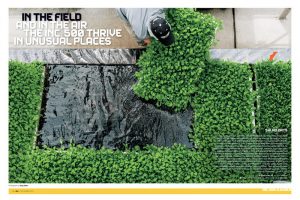After dealing with the high costs and logistical nightmares of developing in urban areas, one farming startup realized that they could streamline their process by moving just a bit outside the city limits.
When the urban farming startup BrightFarms first launched, it envisioned building its hydroponic greenhouses directly on grocery store roofs and on vacant city lots. Now, it says that the smartest place to grow food for cities may be just outside of them.
The company’s newest site will be in the town of Wilmington, Ohio. With a population of only 12,459, it’s not the target market. But it’s near Dayton, Columbus, and Cincinnati, which together have a population over a million people.
BrightFarms also has greenhouses in Bucks County, Pennsylvania; Culpeper County, Virginia; and Rochelle, Illinois—all also near, but not in, large cities. The new strategy lets the company avoid the costs and challenges of working on urban sites, while still providing a local version of foods like salad greens that would normally travel thousands of miles.
“Like most good strategies, it was driven by some painful experiences,” Paul Lightfoot, CEO of BrightFarms, tells Co.Exist. “Basically, we had a couple of failures. We tried to develop a giant rooftop of a building in Sunset Park, Brooklyn, and we also tried to develop an environmentally soiled parcel of land in the city of Washington D.C., owned by the city.”
In both cases, the landowners were eager for BrightFarms to build, and they had strong support from the communities and city leaders. But both sites had challenges. In Brooklyn, the roof needed complex engineering work that couldn’t be completed on the startup’s timeline; in D.C., the city had to do environmental remediation that also took longer that was commercially viable.
Both cities also had complex regulations that weren’t created with urban agriculture in mind. “We found ourselves dealing with a regulatory framework that didn’t understand us, and didn’t have the ability to adapt to us,” Lightfoot says. The projects were classified as “industrial” rather than agricultural, which triggered regulations that didn’t fit.
In smaller communities, the experience was radically different. In Virginia, because it was considered an agricultural project, it was exempt from the typical permitting process. “I think we got the permit in a week,” Lightfoot says. “In D.C., we spent a year getting it.”
The company realized that even if it built outside city limits, it could still stay close enough that transportation would be negligible. BrightFarms sells its produce in 150 stores in the D.C. market, and even if its greenhouses were inside city limits, it would still require driving fairly long distances to make deliveries to all of the stores.
“Being in the city center is not logistically a benefit,” Lightfoot says. “Being 30 miles out of the city is just as good as being in the city. The extra cost of building in a city has absolutely no benefit except for maybe shallow, fake marketing, but it has a real significance in terms of capital costs, and in some cases, operation costs as well, including utilities and transportation.”
BrightFarms’ greenhouses often make use of underutilized spaces: In Rochelle, Illinois, they’ve set up on an empty lot between a distribution center and a factory that was once farmland, then an industrial park.
Even though BrightFarms sometimes establishes its greenhouses near traditional farms, the startup isn’t directly competing with the other operations because it’s focused on tomatoes and greens that typically come from California or Arizona. The greenhouses grow the food with a tiny fraction of the water, and provide it fresher to customers. Less perishable crops, such as root vegetables and corn, are left to traditional farms.
BrightFarms plans to use the same model, building outside cities, as it moves forward. After closing a $30 million equity round in September 2016, it plans to open 14 more greenhouses over the next four years.
By Adele Peters for fastcoexist.com



